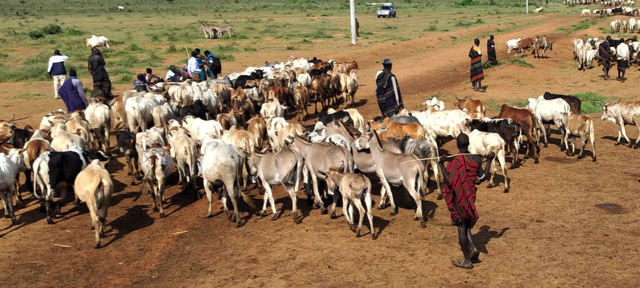
But CSOs say a socialization strategy is better
Kampala, Uganda | RONALD MUSOKE | The Uganda government will in July next year deploy a Livestock Identification and Traceability System (LITS) in the northeastern region of Karamoja in an attempt to solve the age-old problem of cattle rustling.
Robinah Nabbanja, Uganda’s Prime Minister explained the plan to Parliament on Nov. 24. Nabbanja who is the leader of government business in Parliament said the government is also reviewing the Penal Code Act with the intention of introducing offences related to cattle rustling in the law.
Nabbanja was updating MPs on actions taken by ministries, departments and agencies in regards to a number of resolutions the 11th Parliament has passed from May 2021 to May 2022.
Anti-cattle rustling technology
In its effort to deter raids and ease the monitoring, tracking and recovery of any raided or stolen livestock, Nabbanja told MPs that Cabinet had directed the Ministry of Agriculture, Animal Industry and Fisheries (MAAIF) to introduce a programme that will brand and tag all livestock in Karamoja and the neigbouring sub-regions of Teso, Lango, Sebei, and Bugisu.
If this programme goes according to plan, it will become the latest initiative that is aimed at bringing peace and stability to the Karamoja region which has recently seen a recurrence of cattle rustling following almost a decade of relative peace.
The proposed tag and trace system follows one on “kraal intelligence units” that President Yoweri Museveni mooted while on a visit to the sub-region last year.
Museveni said the insecurity in Karamoja is based on laxity by state actors, revenge attacks and inter-clan clashes as well as hunger. Museveni said he would soon bolster the UPDF brigade in the sub-region to 70,000 personnel.
He also proposed forming “kraal intelligence units” to break the criminal alliances among clans which are said to be behind the escalating tension and insecurity in Karamoja.
“What I want is kraal-based intelligence. I need an informer per kraal. Our army has the capacity to reach anywhere day or night in one hour.
“We shall provide small phones to the informers to call security contacts,” Museveni told local leaders who included Resident District Commissioners, LCV chairpersons, heads of security organs, 26 MPs who represent Karamoja in Parliament in Kampala. But local leaders told him there is need for the state to create meaningful relations between security services, community leaders and kraal leaders.
In April, this year, President Museveni also launched a disarmament exercise in Karamoja and deployed the military to carry it out following a spate of murders and theft of thousands of livestock, mainly cattle.
Just within months of the operation, the UPDF declared a success after recovering 148 illegal firearms. But MPs from Karamoja and civil society accused the national army of human rights violations in the region. Sporadic attacks also continue in some parts of the region.
In fact, in July, this year, Karimojong bandits attacked a highly protected kraal in Nabilatuk District, one of the nine districts that make up this vast sub-region. The rustlers stole over 40 head of cattle and killed an anti-stock theft police officer.
However, Nabbanja told MPs that the Ministry of Agriculture, Animal Industry and Fisheries in collaboration with Makerere University’s College of Veterinary Medicine, Animal Resources and Bio-security Studies has developed the Livestock Identification and Traceability System (LITS) to address cattle rustling, theft and animal health.
The system, she said, is based on radio frequency intermittent device (RFID) technology enabled by satellite. It involves tagging the livestock with a paired ear-tag (ordinary and electronic tag) in which a chip is embedded. The chip bears all the information about the animal (bio-data, ownership, and location).
The chip enables identifying the individual animal and this information can be read by a hand-held electronic reader and is also reflected at the district and central servers. It enables real-time tracking of the movement of the livestock. It also enables investigation and tracing the livestock wherever they are in case of being rustled or stolen.
The chip also provides information on livestock population and livestock off-take/sale/change of hands. It therefore gives trends analysis. The system enables authorities to trace origins of specific animal diseases by the trace-back of the source animals thereby being able to control disease from source and prevent further spread.
“The LITS software and hardware requirements have been developed/determined (and) a plan and budget for piloting and later implementing the system is being developed for submission to Cabinet and Parliament for consideration,” Nabbanja told the MPs.
She said the government is formulating a law on livestock identification and traceability system (LITS) that will make it mandatory for all livestock to be registered, tagged and reflected on a national livestock database. Principles for the LITS Bill are also being developed for consideration by Cabinet.
But will this scheme finally bring peace to Karamoja and its neighbouring communities?
Karamoja Cluster
Researchers at the Pretoria-based Institute of Security Studies say Uganda’s northeastern region is part of the so-called Karamoja Cluster that straddles Uganda, South Sudan, Ethiopia and Kenya—and which is beset by cattle rustling and banditry.
It is an expansive arid region, physically isolated from its four constituent centres of power and historically marginalised. It receives less than 300mm of rain annually, making communities dependent on cattle rather than rain-fed agriculture as their primary source of income.
In this extensive territory, cattle herding is often accompanied by cattle raiding, a cultural practice where Karakunas (armed warriors) forcefully break into kraals to steal cattle. Usually, the researchers explain, the primary aim is to accumulate cows as a symbol of status and pride.
The practice, the researchers say, is also undertaken to acquire the cows a Karimojong bridegroom needs to pay the dowry for his bride. However, the proliferation of guns in the area is shifting the socio-cultural and economic practice of cattle raiding into cattle rustling.
The latter is more violent, resulting in injury and death, property destruction, livestock loss and displacement of people in and beyond the Karamoja Cluster. In a region with limited or no government presence, illegal arms are trafficked easily.
Both state and non-state actors are implicated in gun-running and ammunition sales to locals. Despite recognizing the urgency of the situation, workable solutions seem to evade the region’s governments.
Pastoralist warriors use illicit firearms to attack villages, often driving livestock to markets in urban centres to meet the increasing demand for beef. These markets are controlled by cattle warlords who transport them to international markets in the Middle East, for example.
However, although countries that make up the Karamoja Cluster have tried to combat cattle rustling and illicit arms flows to the region, there has not been much respite in this region and its neighbouring communities.
The four governments have in the past tried to disarm, demobilize, and reintegrate the bandits into regular lifestyles. The governments have also attempted carry out cordon and search operations—in which soldiers surround villages to prevent cattle raiders from escaping with stolen livestock. Police have also increased patrols and curfews.
The governments have also experimented with developmental measures, creating agencies focused on the area and offering alternative livelihoods with development partners and local civil society organisations complementing government peace building initiatives.
But the researchers say while some of these initiatives have worked,most have failed because they are short-term, small-scale, poorly integrated, and thus unsustainable.
In their paper published on Nov.17 this year, the researchers noted that if cattle rustling and gun-running in the Karamoja Cluster are to be dealt with decisively, security responses should be more coherent, longer-term and harmonized with development and livelihood options.
In their paper titled, “No Silver bullet to stop cattle rustling in East Africa,” Tadesse Simie Metekia, a senior researcher, Willis Okumu, a senior researcher and Mohamed Daghar, a Regional Organized Crime Observatory Coordinator of ENACT, a programme implemented by the Institute for Security Studies in partnership with INTERPOL and the Global Initiative Against Transnational Organized Crime (ENACT), note that rather than weaning the Karimojong off pastoralism, the pastoralist economy needs to be reinvigorated.
The researchers say the four countries must work to improve infrastructure, water, health, education and security for pastoralists.
They also note how East African countries should use the revised Mifugo Protocol against cattle rustling—which seeks to harmonise and strengthen police cooperation and joint strategies—to coordinate their responses.
For Leonard Okello, the CEO of the Uhuru Institute for Social Development, a Kampala-based think tank, the government’s initiative is commendable but it will not solve the challenges Karamoja is grappling with in regards to cattle rustling.
“The challenges of Karamoja are beyond technology,” Okello told The Independent on Dec.2. “The cattle rustling issue is complex; it is steeped in the social fabric of the Karimojong and it has been made even more complex following its recent commercialization.”
Okello told The Independent that while the government is working on the security and even technology to control cattle raiding in Karamoja, there is also need for the government to deliberately work and improve the relationship between the state and the cultural institutions in Karamoja.
He also thinks the socio-economic infrastructure in the region needs to improve by particularly expanding education in the region.
Okello told The Independent that he feels the Karimojong are not integrated enough in Uganda. “This part of socialization strategy is still missing when it comes to weaning the Karimojong off cattle rustling.”
****
 The Independent Uganda: You get the Truth we Pay the Price
The Independent Uganda: You get the Truth we Pay the Price


